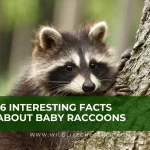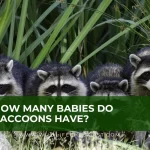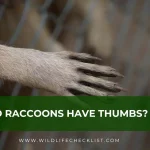Can Cats and Raccoons Mate?

Have you ever wondered if cats and rats can actually reproduce? It’s a question that frequently interests many and causes us to consider the natural world’s secrets. In this article, we will look into the biology of cats and raccoons.
Together we will learn about the unique traits that identify them and add to their reproductive seclusion. From there, we’ll look at the essential factors that decide whether two species can successfully have offspring.
We will also study the idea of genetic compatibility because it is critical to practical breeding. This will help us to better understand the possibility of cat and raccoon hybridization. By discussing the problems of genetic differentiation and the importance of similar evolutionary routes.
Contents
Can Cats and Raccoons Mate?
Due to their similar sizes, cats and raccoons could breed in cities. Many people go to the extent of arguing the possibilities of this without considering the biological makeup of these two animals. Let’s dig into the exciting world of species and reproductive compatibility to understand why it might not be possible.
The chance of successful mating between different animal species relies on genetic endowment, natural past, and reproductive behavior.
Biological Differences Between Raccoons And Cats
Raccoons and cats are two separate species with distinct biological differences. Slender bodies, razor-sharp retractable claws, and improved night vision are traits shared by tame and wild cats. In their oral structure, sharp molars and canines are used for ripping and crushing food.
On the other hand, raccoons are bigger, have thicker fur, and have covered mouths. They feature agile front legs that may be used for climbing, handling, and posable fingers. Also, raccoons have sharp, non-retractable claws.
Raccoons have a yearly reproductive rhythm and are socially flexible, while female cats have an estrus cycle and show distinct mating behaviors. Their different developmental paths and environmental adaptations are mirrored in these biological differences.
The Key Variables That Determine Whether Raccoons And Cats Can Truly Reproduce
Let’s dive into the fascinating world of raccoons and cats and study the key factors that decide whether they can genuinely breed. Get ready for an exciting trip into the world of inter-species mating!
Genetic Compatibility
Raccoons and cats belong to different taxonomic groups. Cats are part of the Felidae family, while raccoons fall under the Procyonidae family. These groups have grown separately for millions of years, resulting in big genetic differences.
Interbreeding between such genetically different species is highly rare due to the genetic walls that have formed over time. It’s like trying to fit a square peg into a round hole!
Reproductive Behavior
Cats and raccoons have different breeding habits and patterns. Cats are known for their unique reproductive system, where the female releases eggs that need to be fertilized by the male’s sperm during copulation. Raccoons, on the other hand, follow a similar process of internal breeding.
While both species have a mating season, their habits and breeding practices vary greatly. This difference in sexual behavior makes it challenging for them to reproduce safely. They don’t dance to the same beat!
Anatomy and Physiology
The physical shape of the reproductive organs and the processes involved in fertilization play a crucial part in finding reproductive compatibility. Cats have a unique penile structure with backward-facing spikes that cause ovulation in females during mating.
Raccoons, however, hold a different penile structure without these spikes. This physical difference causes a mismatch between the reproductive systems of cats and raccoons, making it highly difficult for them to breed properly. It’s like trying to fit a square peg into a triangular hole!
Gamete agreement
Successful breeding needs an agreement between the gametes of the male and female. Cats produce sperm with specific traits meant for fertilizing cat eggs, while raccoons produce sperm perfect for fertilizing raccoon eggs.
The differences in gametes between these species could prevent fertilization, reducing the chances of successful breeding. It’s like trying to mix oil and water – they just don’t blend well!
Viability of children
Even if, by some fantastic chance, a combination were to appear, the viability of the resulting children would be questionable. The genetic mismatch could lead to various health problems and flaws in mixed children, compromising their chances of life and sexual success.
The ability of these freaks to pass on their genetic features to future generations would also be limited due to the genetic mismatch. It’s like trying to build a house on shaky ground!
Natural Selection
Nature has its own way of picking and keeping the best organisms through the process of natural selection. While inter-species hybrids can occur in rare cases, the chances of these hybrids successfully competing and adjusting to their surroundings are low.
Natural selection favors people with traits that are well-suited to their unique natural area. The DNA differences between raccoons and cats may hinder the mixes’ growth ability in either species’ surroundings. It’s like trying to find a needle in a haystack!
Can Cats And Raccoons Be Friends?
Since raccoons and cats have different social structures, instincts, and behaviors, they don’t typically become friends. Cats are territorial animals and typically prefer the companionship of other cats or trusted humans.
On the other hand, raccoons are scavengers that inhabit the wild. It’s best to keep them away and avoid any potential conflicts in order to ensure the safety of both animals, despite the occasional occurrences of brief toleration or curiosity between them.
Conclusion
Now you should be able to answer the question ‘Can Cats and Raccoons Mate?’ As shown in the article, we have discovered the impact of reproductive behavior, genetic compatibility, and natural past for mating to be successful. Interbreeding between cats and raccoons is unlikely because of their genetic makeup, reproductive processes, and behavioral patterns.
At this point, it is crucial to stress the value of proper pet ownership and wildlife protection. Even if the thought of cat-raccoon hybrids may catch our attention, it is crucial to put domestic cats and wild raccoons’ health first.
Let’s observe the natural limits while appreciating the variety and singularity of the animal world. By doing this, we can protect our beloved feline friends’ natural environments and their wild peers.
While the idea of a cat and raccoon mating may excite us, we should be thrilled by each species’ unique traits and beauty. Because of the distinct differences between cats and raccoons, nature has its own fascinating methods of doing things.




